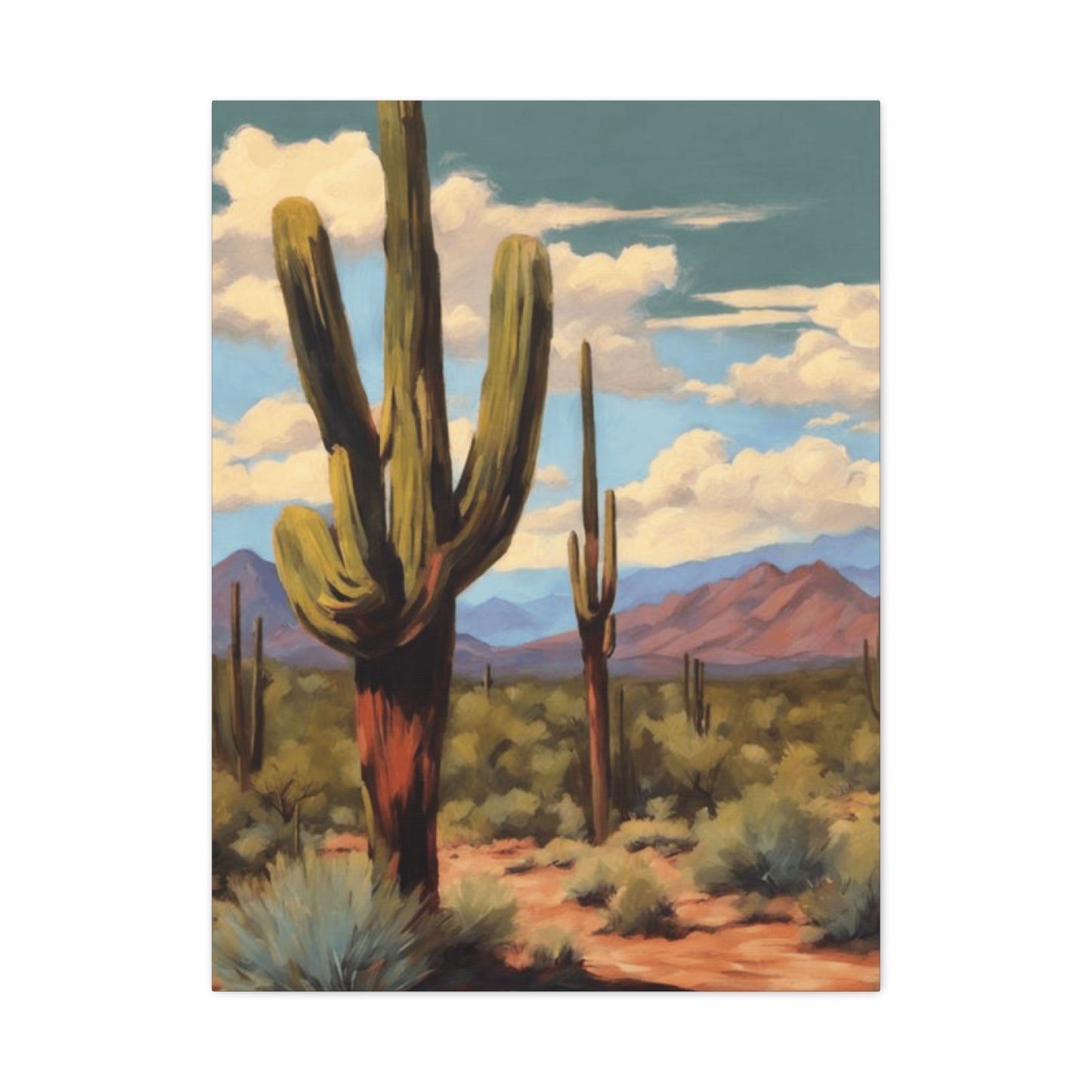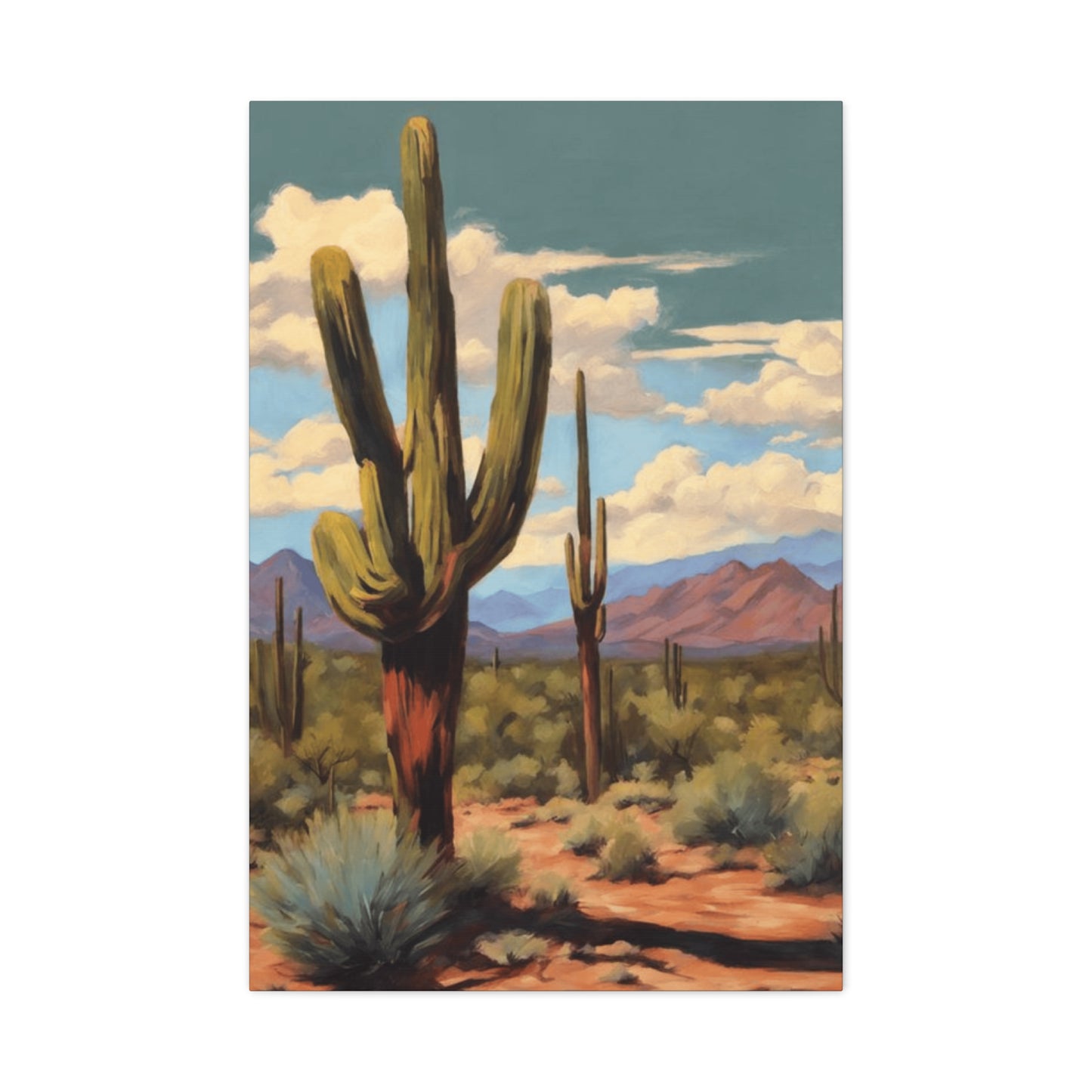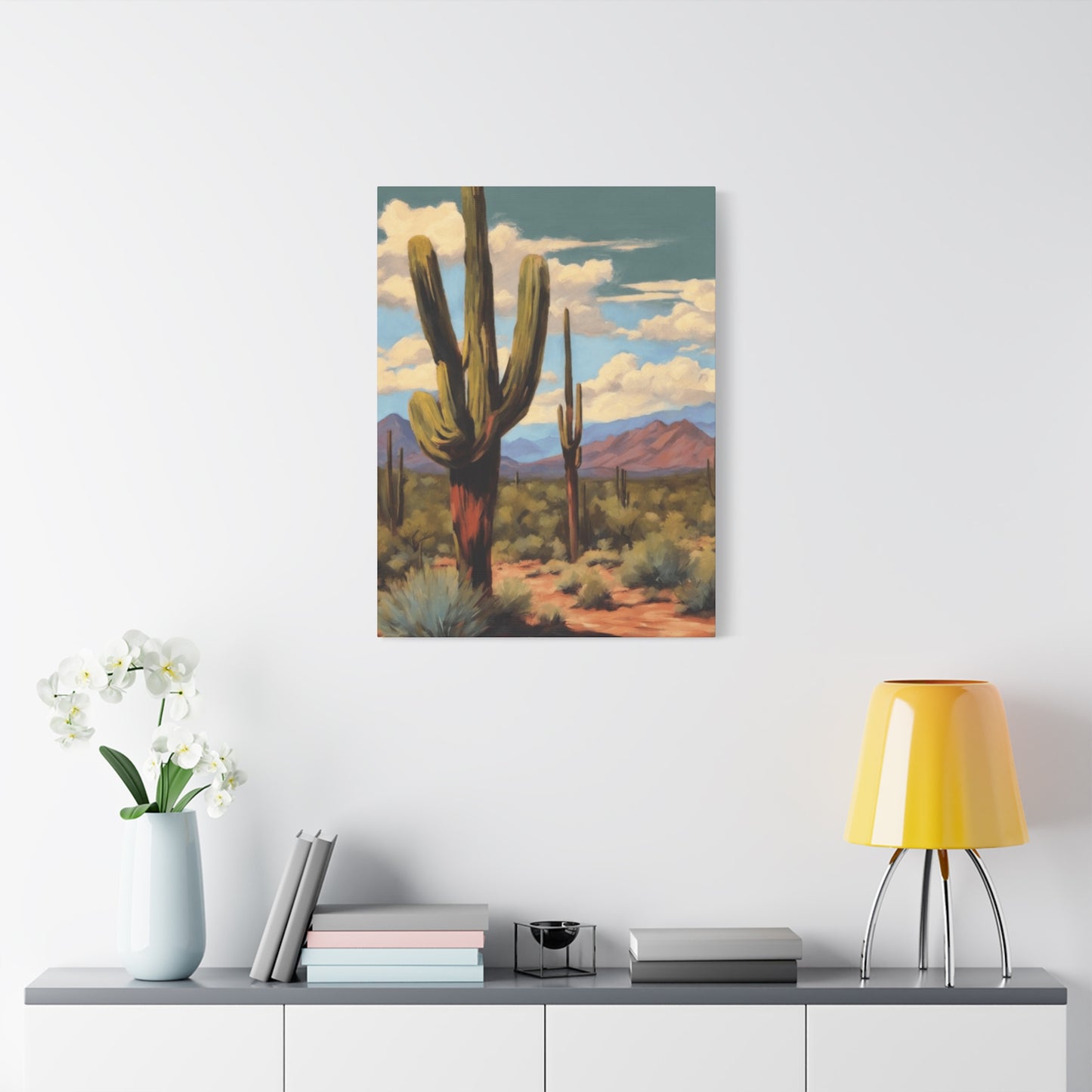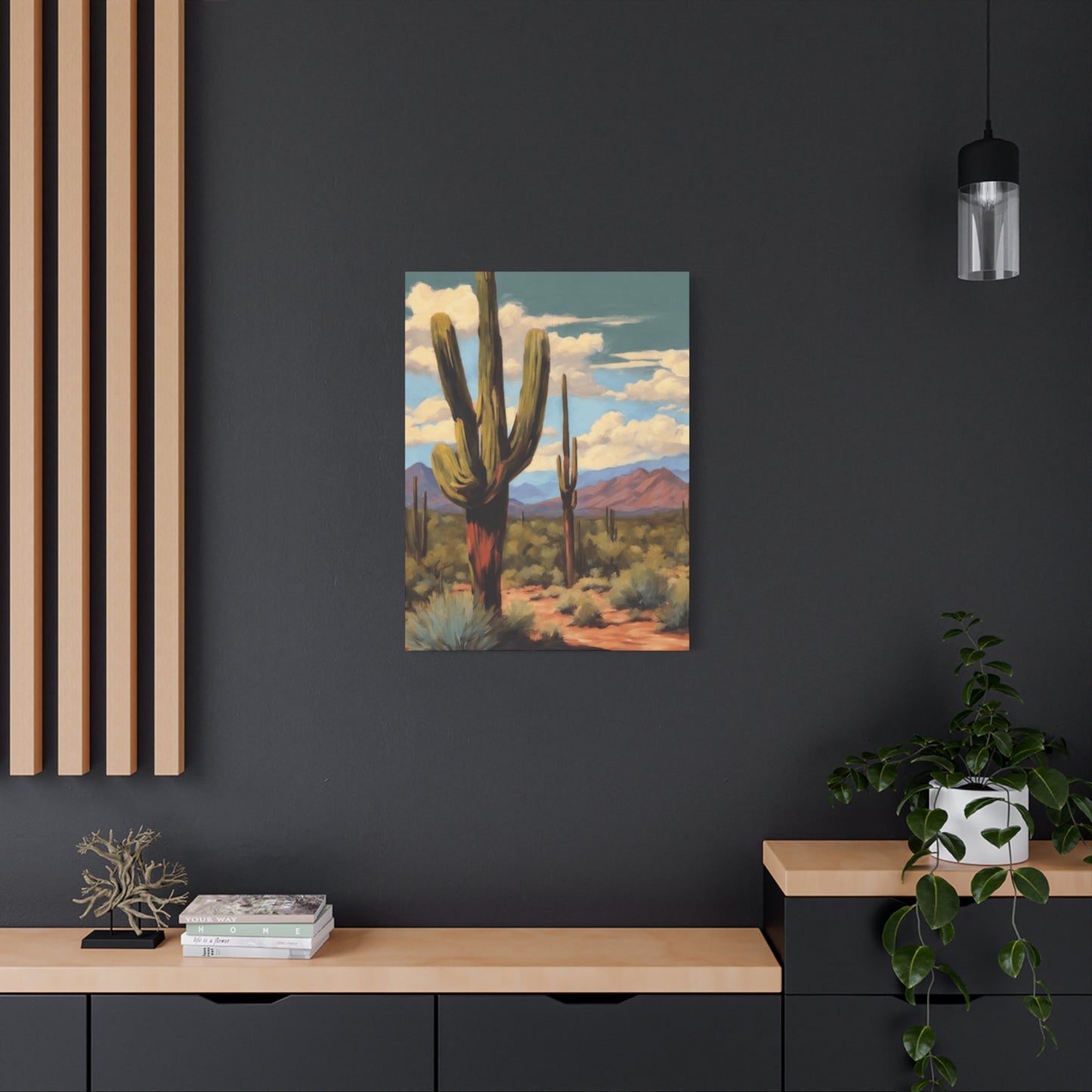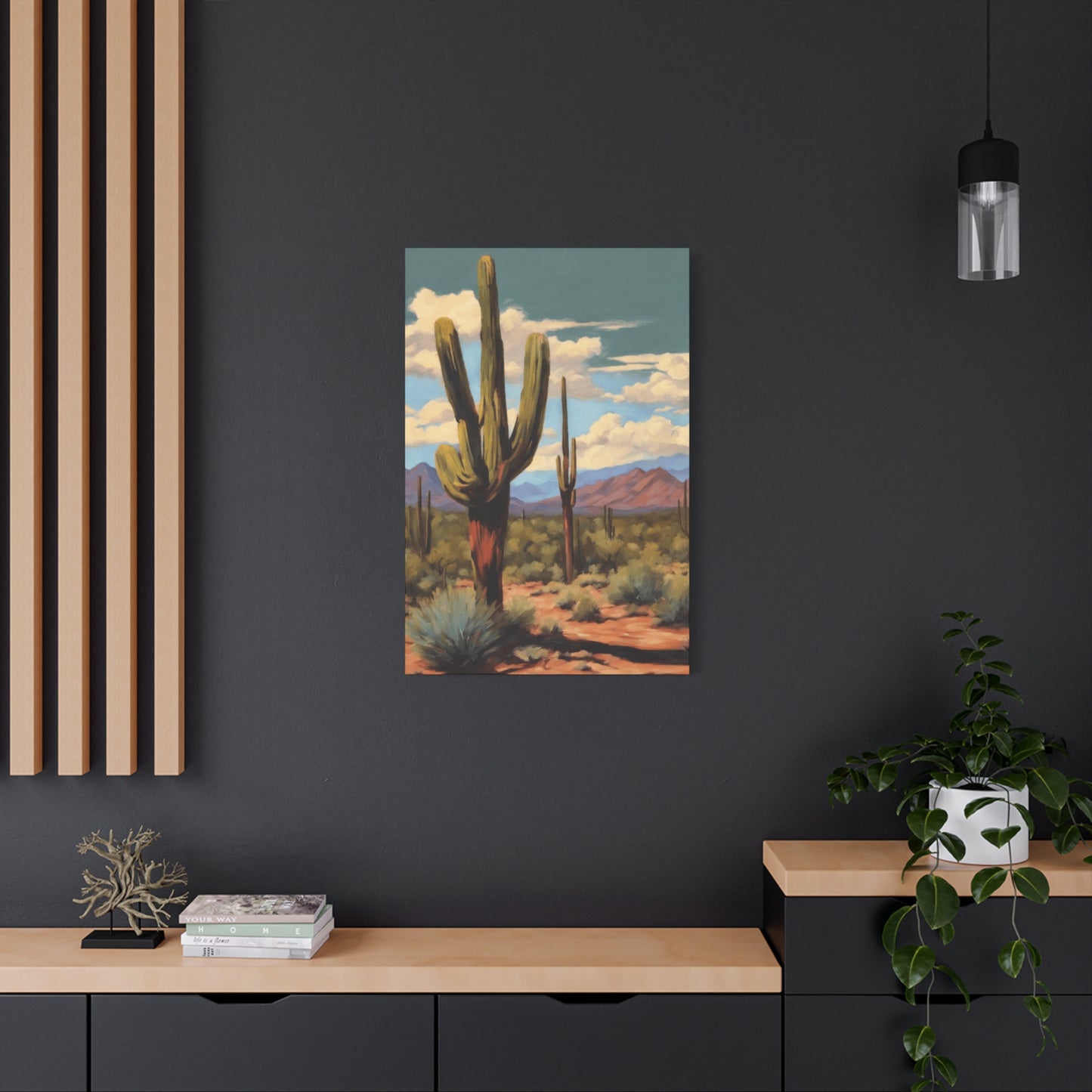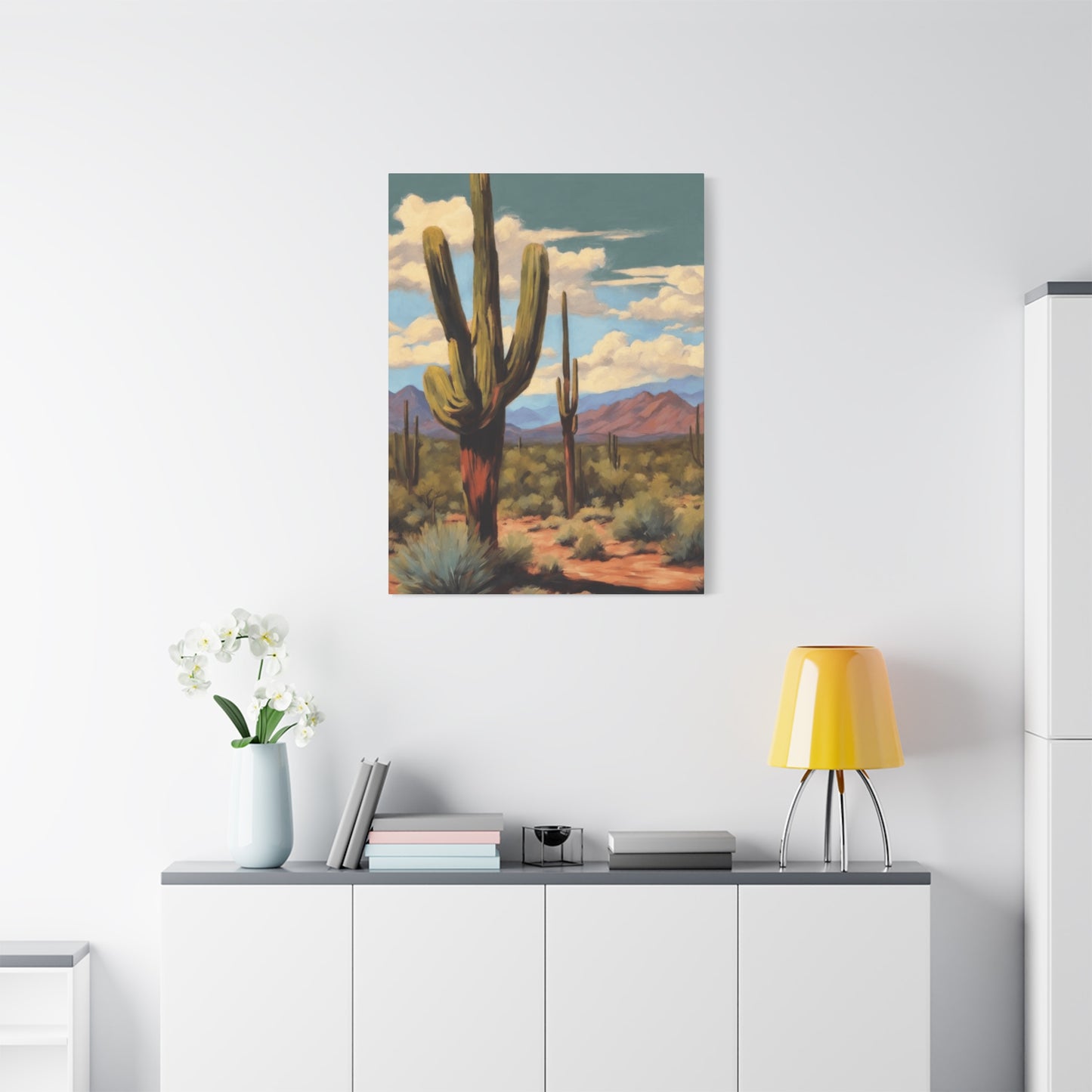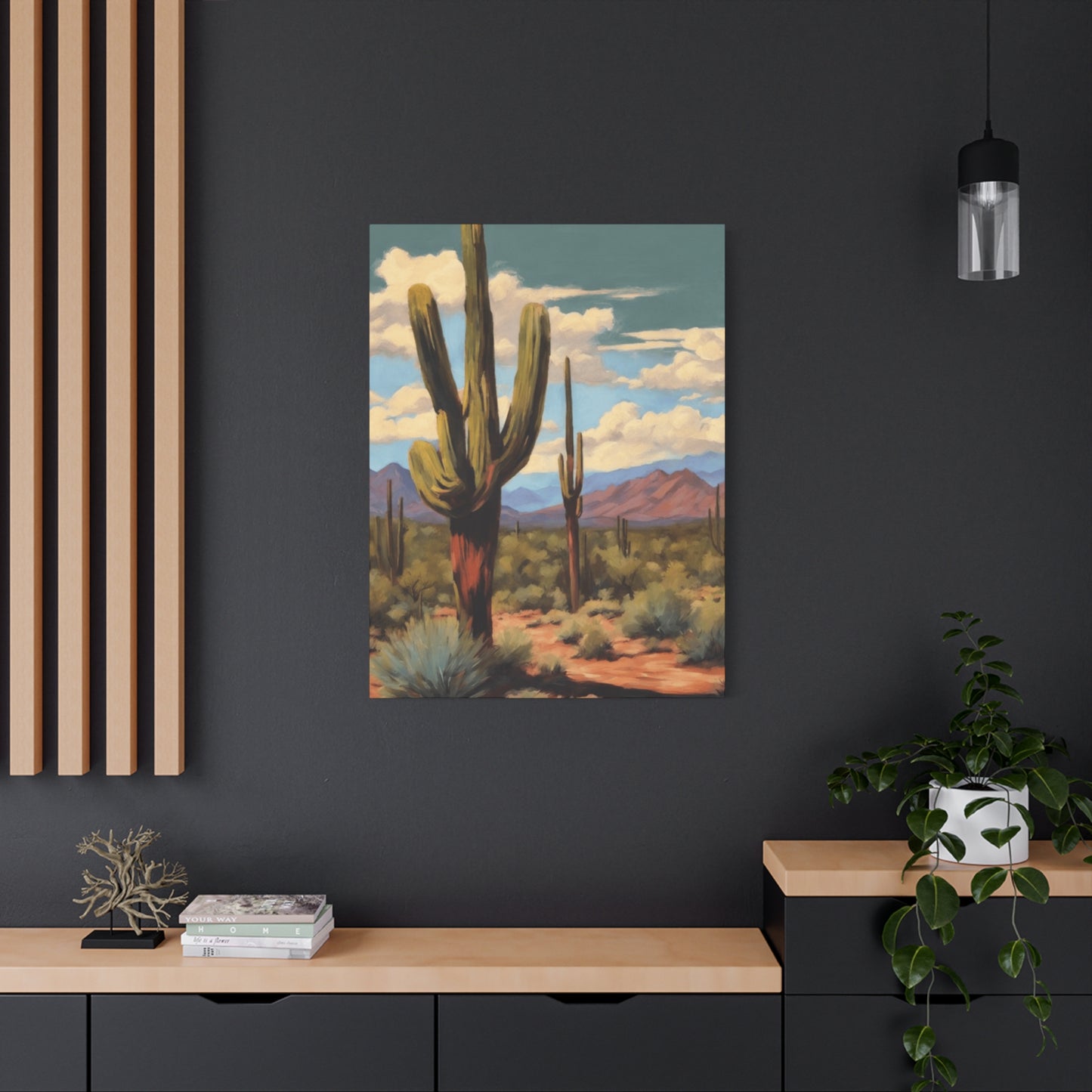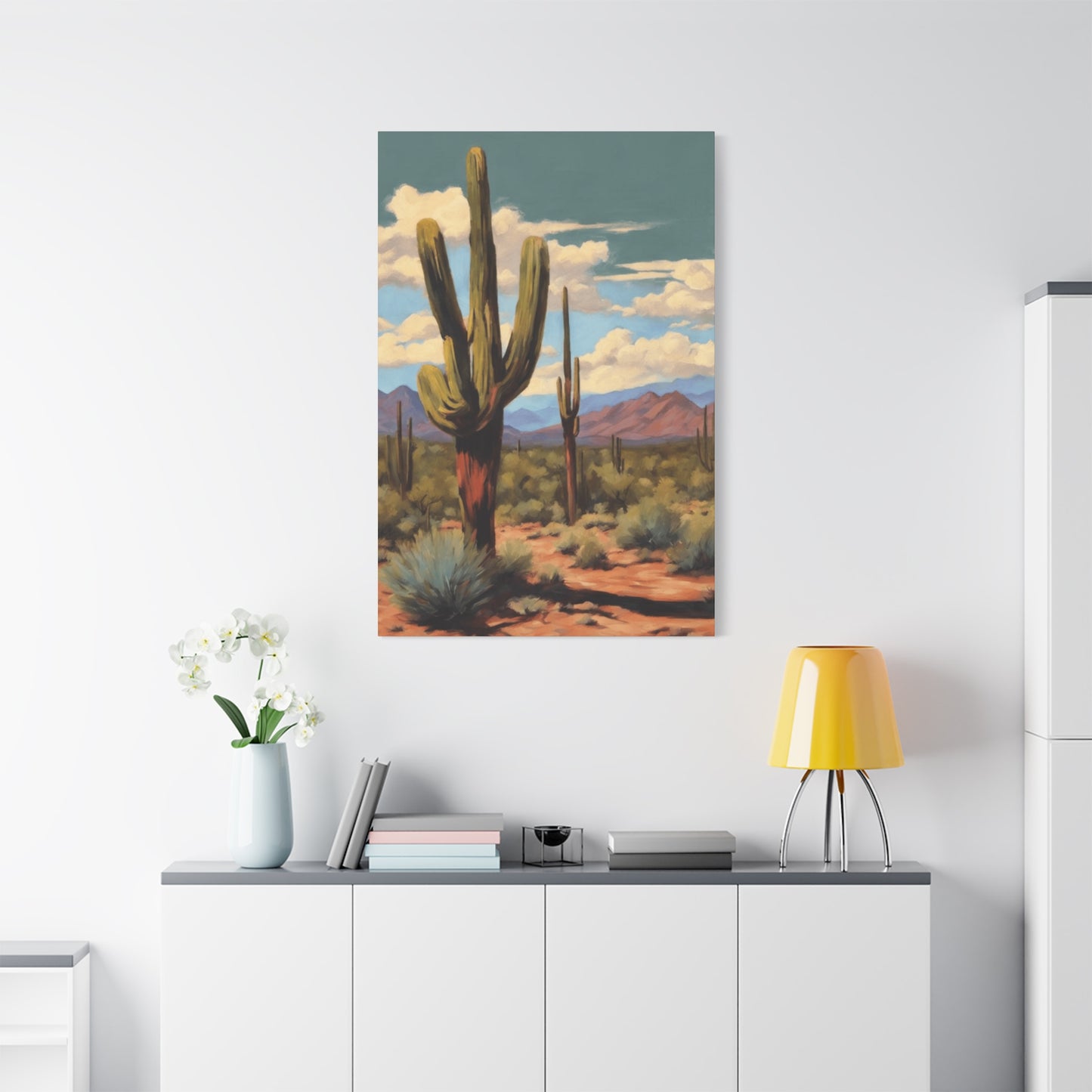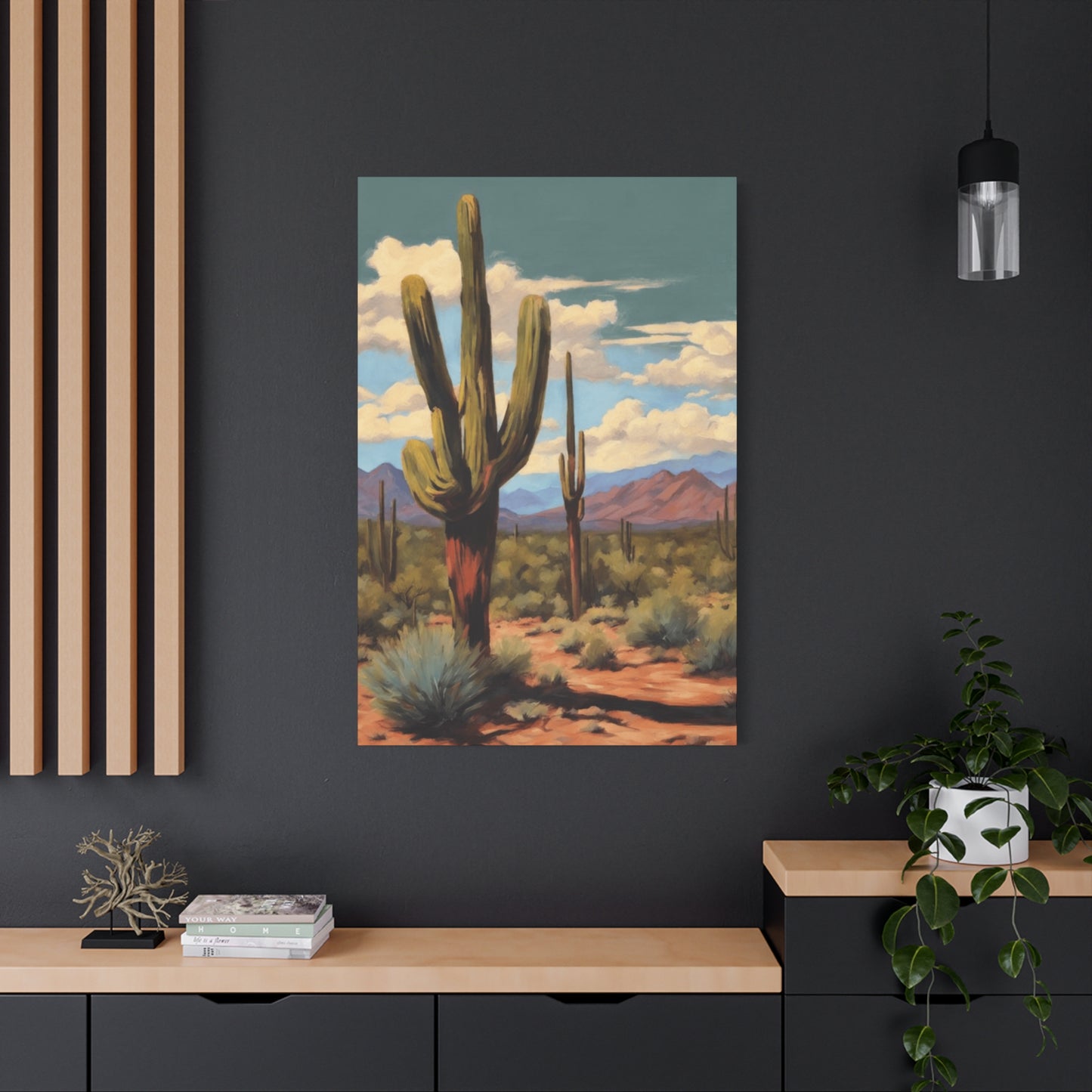Cactus Standing in Desert: A Symbol of Resilience in Painting Wall Art prints
The imagery of a cactus standing tall in the vast expanse of desert terrain has captivated artists, designers, and homeowners for generations. This powerful visual representation transcends mere decoration, embodying themes of survival, strength, and natural beauty that resonate deeply with contemporary audiences. The solitary cactus, rooted firmly in arid soil beneath an expansive sky, tells a story of endurance that speaks to the human spirit. As interior design trends continue to evolve, the appeal of desert-inspired artwork has surged, with cactus imagery becoming a staple in homes, offices, and creative spaces worldwide. These artworks serve not only as aesthetic enhancements but as meaningful symbols that connect urban dwellers to the raw, untamed beauty of nature.
The desert landscape, with its stark beauty and dramatic contrasts, offers a visual language that translates remarkably well to wall art, bringing a sense of groundedness and perspective to any environment. In an age where many feel disconnected from the natural world, cactus desert paintings provide a vital link to landscapes that have existed for millennia, unchanged and uncompromising in their majesty. The growing popularity of these artworks reflects a broader cultural shift toward valuing authenticity, resilience, and the enduring power of nature in our daily lives.
How Cactus Desert Paintings Add Drama to Your Walls
The visual impact of cactus desert paintings cannot be overstated when considering options for transforming blank walls into captivating focal points. These artworks possess an inherent dramatic quality that stems from the stark contrasts present in desert environments themselves. The interplay between light and shadow across cactus forms creates dynamic visual interest that draws the eye and holds attention. Desert paintings featuring cacti typically showcase bold silhouettes against expansive skies, often rendered in sunset hues of orange, pink, and purple, or the deep blues and blacks of twilight. This natural drama translates powerfully to canvas, instantly elevating the energy of any room.
The compositional strength of cactus imagery lies in its vertical elements that command presence without overwhelming a space. Unlike busy patterns or complex scenes that can feel chaotic, a well-executed cactus painting offers structured drama that feels both powerful and peaceful. The sculptural quality of cacti, with their distinctive shapes and textures, provides visual weight that anchors a room's design scheme. Whether depicted in realistic detail or abstract interpretation, these desert guardians bring an element of the unexpected to interior spaces, challenging conventional decoration while remaining accessible and appealing.
Color palettes in desert cactus paintings range from vibrant and energetic to subdued and contemplative, allowing for dramatic effect regardless of your preferred aesthetic. Warm terracottas, burnt siennas, and golden yellows evoke the heat and intensity of midday desert sun, while cooler tones of sage, dusty blue, and weathered gray capture the serene qualities of desert dawn or dusk. The textural possibilities are equally varied, from smooth, stylized renderings to rough, impasto techniques that add physical dimension to the canvas. This versatility ensures that cactus desert paintings can provide exactly the level of drama your space requires, whether you're seeking a bold statement piece or a more subtle enhancement.
Bringing the Desert Landscape Indoors with Cactus Wall Art
Creating an indoor connection to outdoor environments has become a fundamental principle of contemporary interior design, and cactus wall art serves as an exceptional bridge between indoor comfort and desert wilderness. The psychological benefits of incorporating nature-inspired elements into living spaces are well-documented, with studies showing that natural imagery can reduce stress, improve focus, and enhance overall wellbeing. Cactus desert paintings offer these benefits while adding a distinctive aesthetic that sets them apart from more common nature themes like forests or ocean scenes.
The process of bringing desert landscapes indoors through artwork begins with understanding the unique characteristics that define desert environments. These landscapes are characterized by openness, vast horizons, and a sense of limitless space that can be remarkably refreshing in our often-confined indoor environments. Cactus imagery captures this expansiveness while providing focal points that prevent the composition from feeling empty or incomplete. The result is artwork that opens up a room visually, making even smaller spaces feel more spacious and connected to the wider world beyond their walls.
When selecting cactus wall art to bring desert landscapes indoors, consider how different artistic styles can create varied atmospheres. Photorealistic paintings transport viewers directly to specific desert locations, offering almost window-like views into arid terrain. More impressionistic or abstract interpretations, meanwhile, capture the essence and feeling of desert landscapes without literal representation, allowing for broader interpretation and personal connection. Mixed media pieces that incorporate actual sand, stone, or other natural materials add tactile dimension that further enhances the sensory connection to desert environments.
The arrangement and placement of cactus wall art significantly impacts how effectively it brings the desert landscape indoors. Gallery walls featuring multiple cactus paintings at different scales can create a comprehensive desert narrative, while a single large piece can serve as a dramatic portal to desert vistas. Pairing cactus artwork with complementary design elements like natural wood, woven textiles, and earth-toned ceramics reinforces the desert connection and creates a cohesive environment that feels authentically inspired rather than merely decorated. Lighting also plays a crucial role; warm-toned illumination mimics desert sunlight and enhances the natural qualities of the artwork, while strategically placed spotlights can create shadows and highlights that add depth and dimension to the painted cacti.
Why Cactus Desert Paintings are Perfect for Modern Decor
Modern interior design principles emphasize clean lines, uncluttered spaces, and thoughtful selection of decorative elements that serve both aesthetic and functional purposes. Cactus desert paintings align remarkably well with these principles, offering visual interest without excess ornamentation or complexity. The simplified forms of cacti translate beautifully to modern design sensibilities, where less is often more and every element must earn its place. Unlike busy traditional artwork that might feel overwhelming in minimalist modern spaces, cactus paintings provide just enough detail and interest to activate a wall without dominating it.
The color palettes commonly associated with desert landscapes complement modern design schemes exceptionally well. Neutrals like sandy beige, warm gray, and soft white form the foundation of both desert environments and contemporary interiors, creating natural harmony when these elements come together. Accent colors found in desert sunsets or flowering cacti can provide pops of interest that enliven neutral spaces without disrupting their calm sophistication. This color compatibility means cactus desert paintings can integrate seamlessly into existing modern decor or serve as inspiration for new color schemes that feel both current and timeless.
Modern design also values authenticity and connection to natural materials and forms, moving away from artificial or overly processed aesthetics. Cactus imagery embodies this authenticity, representing plants that have evolved over millennia to survive in harsh conditions without human intervention or cultivation. This untamed quality appeals to modern sensibilities that appreciate rawness and genuine character over polish and perfection. In a world increasingly dominated by technology and synthetic materials, the organic forms and natural textures of cacti offer a grounding counterbalance that feels essential rather than merely decorative.
The geometric qualities inherent in many cactus species also resonate with modern design's appreciation for structure and form. The vertical columns of saguaro cacti, the spherical forms of barrel cacti, and the angular segments of prickly pear all exhibit geometric properties that feel architecturally inspired. These shapes create visual dialogue with the straight lines and clean angles typical of modern furniture and architecture, establishing aesthetic continuity throughout a space. This geometric harmony allows cactus desert paintings to feel like natural extensions of the architectural environment rather than foreign additions imposed upon it.
How Cactus Standing in Desert Paintings Create a Calming Vibe
The calming qualities of cactus standing in desert paintings stem from multiple visual and psychological factors that work together to create a sense of peace and tranquility. Desert landscapes possess an inherent stillness that translates powerfully to artwork, offering viewers a respite from the constant motion and stimulation of modern life. When a cactus stands alone in vast desert expanse, the image conveys patience, permanence, and a slow passage of time that counters the frantic pace many people experience daily. This visual representation of unhurried existence can have a profoundly calming effect on viewers, encouraging them to slow down and breathe more deeply.
The color psychology behind desert cactus paintings also contributes significantly to their calming impact. Earth tones dominate these compositions, featuring colors that humans have evolved alongside for millennia. These familiar, natural hues create subconscious associations with safety, stability, and connection to the earth itself. Soft greens of cactus bodies, warm browns of desert soil, and gentle blues of cloudless skies all fall within color ranges that researchers have identified as particularly soothing to human psychology. Unlike bright, stimulating colors that energize and activate, these muted desert tones relax and restore, making them ideal for spaces intended for rest and reflection.
The composition and negative space in cactus desert paintings play crucial roles in generating calm atmospheres. Desert scenes naturally incorporate vast amounts of open space, with cacti serving as solitary focal points within expansive emptiness. This negative space is not merely background but an active element that gives the eye room to rest and the mind space to wander. In our visually cluttered world, where advertisements, screens, and busy environments constantly compete for attention, the simple composition of a cactus standing in empty desert offers profound relief. The artwork doesn't demand constant visual processing but instead invites contemplation and peaceful observation.
The symbolic associations of cacti further enhance their calming presence in artwork. These plants represent endurance through difficulty, thriving despite scarcity and harsh conditions. For viewers facing their own challenges, cactus imagery can provide silent encouragement and perspective, reminding them that strength doesn't require constant struggle or visible effort. The cactus simply stands, year after year, embodying a calm resilience that inspires without overwhelming. This quality makes cactus desert paintings particularly valuable in spaces dedicated to meditation, yoga, or therapeutic practices, where creating a calm, supportive environment is paramount.
Cactus Art: A Stunning Tribute to the Beauty of the Desert
The desert environment possesses a stark beauty that has inspired artists across cultures and centuries, and cactus art serves as a particularly powerful tribute to this unique ecosystem. Unlike lush forests or dramatic mountain ranges, desert beauty is subtle and requires patience to fully appreciate. Cacti stand as the most iconic representatives of desert flora, having adapted over millions of years to thrive where few other plants can survive. Artwork featuring these remarkable plants celebrates not just their visual appeal but their incredible evolutionary success and ecological importance.
Desert landscapes challenge conventional notions of beauty that typically favor abundance, greenery, and water. The desert instead offers beauty through minimalism, showing what remains when excess is stripped away. Cactus art captures this essential beauty, focusing on form, texture, and the play of light across surfaces rather than relying on lush colors or complex details. This reductive approach to beauty resonates deeply in our current cultural moment, where many people are seeking to simplify their lives and focus on what truly matters. Cactus artwork becomes a visual reminder that beauty doesn't require abundance or complexity but can exist in the most spare and challenging environments.
The diversity of cactus species provides artists with an extraordinary range of forms and textures to explore. From the towering columns of saguaros that can reach heights of fifty feet to tiny button cacti no larger than a golf ball, these plants exhibit remarkable variety within their shared adaptation strategies. Artists who specialize in desert themes can spend entire careers exploring the subtle differences between species, the way light interacts with spines versus smooth surfaces, or the brilliant but brief blooms that many cacti produce. This depth of subject matter ensures that cactus art never becomes repetitive or exhausted, with each artwork offering new perspectives on desert beauty.
Creating effective cactus art requires understanding the desert environment beyond surface appearances. Successful artists study how desert light differs from light in other environments, noting its particular clarity and the sharp shadows it creates. They observe how desert colors shift throughout the day, from the cool purples and blues of dawn to the intense golds of midday and the dramatic reds and oranges of sunset. They learn to capture the texture of cactus skin, the architecture of spines, and the subtle variations in form that distinguish one species from another. This deep knowledge transforms cactus art from simple decoration into genuine tribute, honoring the desert's beauty with authenticity and respect.
Cactus in the Desert: Perfect for Nature-Inspired Interiors
Nature-inspired interior design has evolved from a niche trend to a dominant design philosophy embraced by homeowners, designers, and wellness advocates worldwide. This approach seeks to reconnect people with natural environments through thoughtful integration of organic materials, natural colors, and imagery drawn from the living world. Cactus in the desert artwork serves as an exceptional foundation for nature-inspired interiors because it represents nature at its most essential and undiluted. Unlike cultivated gardens or managed forests, the desert ecosystem operates according to its own ancient rhythms, untamed and unmodified by human intervention.
Incorporating cactus desert art into nature-inspired spaces creates specific atmospheric qualities that distinguish these interiors from those featuring other nature themes. Forest imagery, for example, tends to create lush, enclosed feelings, while ocean scenes evoke fluidity and constant motion. Desert cactus art, by contrast, introduces qualities of openness, stillness, and endurance. These characteristics complement rather than duplicate the effects of other natural elements commonly used in nature-inspired design, such as houseplants, natural wood, and stone accents. The desert theme adds diversity to the natural vocabulary of a space, preventing it from becoming one-note or predictable.
The textural qualities of cactus imagery enhance the tactile richness that nature-inspired interiors strive to achieve. Even when rendered in two dimensions, the spines, ridges, and varied surfaces of cacti suggest textures that viewers can almost feel. This visual texture complements the physical textures present in natural materials like rough-hewn wood, woven fibers, and unpolished stone. Together, these elements create layered sensory experiences that engage occupants more fully than smooth, uniform surfaces ever could. The human brain is wired to process and appreciate textural variety, finding it inherently interesting and satisfying, which contributes to the overall success of nature-inspired design schemes.
Authentic nature-inspired design requires more than simply adding plant imagery to walls; it demands coherent storytelling that creates believable environmental narratives. Cactus desert art excels at establishing these narratives, particularly when supported by complementary design choices. Pairing cactus paintings with terracotta pots, sandy-colored textiles, and warm lighting creates a cohesive desert story that feels transported rather than assembled. Adding actual succulent plants strengthens the connection, bringing living elements that echo the painted ones. The result is an interior that doesn't just reference nature but embodies it, creating spaces where occupants feel genuinely connected to the natural world rather than merely reminded of it.
How Cactus Desert Paintings Add Texture and Depth to Your Space
Visual texture and perceived depth are crucial elements in creating interiors that feel rich and engaging rather than flat and lifeless. Cactus desert paintings contribute both these qualities through multiple means, beginning with the inherent textural nature of their subjects. Cacti are among the most texturally complex plants in the botanical world, featuring surfaces that range from smooth and waxy to densely covered with spines, hair, or scales. Artists who accurately render these textures create paintings that reward close examination, revealing details that weren't apparent from a distance. This layered viewing experience adds sophistication and staying power to the artwork, preventing it from becoming visually exhausted after brief exposure.
The painting techniques employed in creating cactus desert art significantly impact the texture it contributes to a space. Smooth, precise rendering creates one type of texture, emphasizing the subject's natural surface qualities through careful representation. Impasto techniques, where paint is applied thickly to create physical texture on the canvas surface, add literal three-dimensionality that changes as light shifts throughout the day. Rough brushwork or palette knife application can suggest the raw, weathered quality of desert environments, where everything bears the marks of wind, sand, and relentless sun. Mixed media approaches incorporating sand, stone dust, or other natural materials create actual tactile texture that bridges the gap between two-dimensional representation and three-dimensional reality.
Depth creation in cactus desert paintings operates through multiple compositional strategies that artists have refined over centuries. Atmospheric perspective, where distant objects appear lighter and less distinct than foreground elements, allows artists to suggest vast desert expanses stretching to distant horizons. The eye travels from the detailed, saturated cactus in the foreground through gradually fading middle ground elements to pale, hazy mountains or sky at the painting's edge. This depth progression creates spatial illusion that opens walls visually, making rooms feel larger and less confined. The effect is particularly valuable in smaller spaces where physical depth is limited but visual depth can expand perceived dimensions dramatically.
The interplay of light and shadow in desert scenes provides another powerful depth-creating mechanism. Desert light is famously dramatic, creating sharp contrasts between illuminated surfaces and deep shadows. Artists capture this quality in their paintings, using strong value contrasts to model three-dimensional forms and create a sense of relief and projection. A well-rendered cactus appears to occupy real space rather than lying flat against the canvas, its volume and form clearly communicated through careful observation of how light wraps around its surfaces. This sculptural quality adds depth not just in terms of pictorial space recession but in the physical presence of depicted objects themselves.
The Timeless Beauty of Cactus Standing in Desert Wall Art
Certain artistic subjects possess qualities that transcend temporary trends and maintain appeal across generations and changing design fashions. Cactus standing in desert wall art belongs firmly in this category of timeless imagery, drawing its enduring appeal from deep human responses to both the natural world and the symbolic meanings we project onto it. Unlike trendy subjects that feel dated within years or even months, desert cactus imagery has maintained relevance for over a century of American art and shows no signs of diminishing appeal. This longevity stems from the fundamental nature of what cacti represent rather than superficial stylistic considerations.
The timeless quality of desert cactus art connects to its representation of permanence and endurance in an ever-changing world. While specific design trends come and go, the human need for symbols of stability and resilience remains constant. A cactus that has stood in the desert for a hundred years or more embodies this permanence in ways that resonate across different eras and cultural moments. During times of rapid change or uncertainty, these images provide visual anchors, reminding viewers that some things endure despite surrounding chaos. During more stable periods, they offer appreciation for perseverance and adaptation. Either way, the core message remains relevant and meaningful.
Stylistic flexibility also contributes to the timeless nature of cactus desert art. These subjects lend themselves equally well to realistic, impressionistic, abstract, and modern interpretations, allowing each generation of artists to explore them through contemporary artistic languages without exhausting their potential. A photorealistic cactus painting from the mid-twentieth century can hang comfortably alongside a minimalist abstract interpretation from the current decade because both engage with the essential qualities of their subject rather than merely reproducing surface appearances. This adaptability means cactus art never feels locked into a particular period, maintaining freshness across different stylistic contexts.
The aesthetic versatility of cactus imagery ensures it can integrate successfully into virtually any interior design style, from traditional to contemporary, rustic to refined. A cactus painting in an ornate gilt frame suits traditional decor just as effectively as the same subject in a sleek modern frame complements minimalist spaces. The subject itself possesses enough visual strength to work within these varying contexts without requiring stylistic compromises. This chameleon-like quality is rare in decorative art subjects and contributes significantly to the timeless appeal of cactus desert paintings. Homeowners can invest confidently in these pieces, knowing they won't feel dated as design trends evolve and personal tastes shift over time.
Cactus Desert Paintings: Perfect for Bohemian and Rustic Styles
Bohemian and rustic design styles, though distinct, share certain foundational principles that make cactus desert paintings exceptionally compatible with both approaches. Bohemian interiors celebrate eclecticism, global influences, and artistic freedom, creating spaces that feel collected rather than coordinated. Rustic design, meanwhile, emphasizes natural materials, handcrafted elements, and connection to rural or wilderness environments. Cactus desert art bridges these styles beautifully, offering the earthy authenticity that rustic design requires while providing the exotic, artistic quality that bohemian spaces demand.
For bohemian interiors, cactus desert paintings contribute essential elements of worldliness and artistic sensibility. The American Southwest, where most cactus species thrive, possesses rich cultural traditions that blend Native American, Mexican, and Anglo influences into distinctive artistic expressions. Artwork depicting these landscapes carries echoes of this cultural richness, adding layers of meaning beyond pure aesthetics. The colors commonly found in desert paintings, particularly warm terracottas, deep oranges, and turquoise blues, align perfectly with bohemian color preferences that favor rich, saturated hues over neutrals. These paintings provide grounding focal points within bohemian rooms that might otherwise feel too scattered or chaotic, anchoring the eclectic mix with strong, clear imagery.
Rustic interiors find equally strong partnership with cactus desert paintings, though for somewhat different reasons. Rustic design celebrates the raw, unpolished beauty of natural materials and rural life. Desert landscapes represent nature at its most unadorned and honest, stripped of the lush decoration that characterizes other ecosystems. A cactus standing in rocky desert soil embodies rustic values of authenticity, durability, and connection to land. These paintings complement the weathered wood, rough stone, and simple forms typical of rustic interiors, extending the design language from physical objects to wall surfaces. The artwork transforms walls from neutral backgrounds into active participants in the room's rustic narrative.
Both bohemian and rustic styles benefit from the narrative quality that cactus desert paintings provide. These aren't merely decorative patterns or abstract compositions but representations of real places with genuine character and history. They tell stories of survival, adaptation, and the beauty that emerges from harsh conditions. These narratives resonate with the values underlying both design styles: bohemian celebration of unconventional beauty and rustic appreciation for the authentic and unvarnished. A cactus painting becomes more than wall coverage; it becomes a statement about what the inhabitants value and how they see the world.
Why Cactus in Desert Paintings Evoke a Sense of Peace
The peaceful qualities of cactus in desert paintings emerge from a complex interaction of visual elements, symbolic associations, and psychological responses that together create a profound sense of calm. Desert environments possess an almost otherworldly stillness, largely due to the absence of elements that typically generate sensory stimulation in other landscapes. No rustling leaves, no flowing water, no dense vegetation swaying in breezes. This stillness translates powerfully to painted representations, creating artworks that feel inherently quiet and contemplative. Viewers experience this quietness viscerally, finding their own internal pace slowing to match the eternal patience of the depicted landscape.
The color psychology inherent in desert cactus paintings plays a fundamental role in their peace-inducing qualities. Deserts exist primarily in muted, dusty tones that lack the intensity and saturation that stimulate and energize. These colors, formed by thousands of years of sun exposure bleaching and weathering the landscape, belong to nature's most calming palette. Soft sage greens, warm sandy tans, gentle grays, and faded blues all fall within color ranges that reduce heart rate, lower blood pressure, and promote relaxation. Unlike the bright, primary colors that demand attention and generate excitement, desert colors invite rest and contemplation. They don't compete for attention but offer themselves quietly for appreciation by those willing to truly see them.
Compositional simplicity contributes significantly to the peaceful atmosphere of desert cactus paintings. Unlike busy compositions filled with competing elements and visual pathways, desert scenes typically feature sparse arrangements with clear hierarchies. A single cactus or small group of cacti occupies the foreground or middle ground, while vast empty space surrounds them. This compositional clarity reduces cognitive load, allowing viewers to take in the entire scene quickly without struggling to process complex information. The brain can rest rather than work, and this mental ease translates directly to emotional peace. There's nowhere the eye must go, no puzzle to solve, no hidden elements demanding discovery. The painting simply is, requiring nothing from the viewer but presence and receptivity.
The symbolic associations of desert imagery further enhance its peaceful qualities. Deserts represent retreat, solitude, and separation from the demands of ordinary life. Throughout human history, people have sought deserts for spiritual quests, meditation, and escape from worldly concerns. These associations persist in our collective consciousness, influencing how we respond to desert imagery even when we're not consciously aware of these connections. A cactus standing alone in vast emptiness becomes a visual representation of peaceful solitude, suggesting that it's possible to exist fully and beautifully without constant interaction, stimulation, or busyness. This message offers profound peace to viewers living in overstimulated, hyperconnected modern environments.
Cactus Standing in Desert Paintings: A Bold Focal Point for Any Room
Creating effective focal points is among the most important tasks in interior design, as rooms without clear visual anchors often feel disorganized and uncomfortable regardless of their individual elements' quality. Cactus standing in desert paintings excel as focal points because they possess strong, clear forms that naturally command attention without requiring exaggerated size or extreme styling. The vertical thrust of most cactus forms creates an immediate visual anchor, drawing the eye upward and establishing a clear hierarchy within the room. This vertical emphasis feels particularly powerful in spaces dominated by horizontal lines from furniture, flooring, and architectural elements.
The boldness of cactus desert paintings as focal points stems partly from their inherent contrast with typical interior environments. Most people live and work in spaces far removed from desert landscapes, surrounded by smooth surfaces, controlled temperatures, and abundant water. Introducing desert imagery into these spaces creates instant visual tension, the productive kind that generates interest and engagement. The rough, spined texture of a painted cactus contrasts dramatically with soft upholstery and smooth walls. The vast, open spaces of desert scenes oppose the enclosed nature of interior rooms. These contrasts ensure the artwork stands out distinctly from its surroundings, fulfilling the essential requirement of any successful focal point.
Scale flexibility allows cactus desert paintings to serve as focal points in rooms of varying sizes and proportions. In larger spaces, oversized canvases or multi-panel installations can fill entire walls, creating immersive focal points that transform walls into landscape windows. In smaller rooms, even modestly sized paintings can command focus effectively because the strong compositional structure of desert scenes projects visual power beyond physical dimensions. A two-foot square painting of a striking saguaro cactus can dominate a small room just as effectively as an eight-foot piece dominates a large space, proving that focal point success depends on visual strength and strategic placement as much as physical size.
Strategic positioning maximizes the focal point potential of cactus desert paintings. Placement directly opposite the main entrance ensures the artwork is the first thing seen upon entering, immediately establishing the room's character and mood. Positioning above a fireplace mantel or behind a seating area leverages existing architectural focal points, reinforcing their importance while adding layers of visual interest. In open-plan spaces, a large cactus painting can define zones and provide orientation, helping occupants understand spatial organization. Regardless of specific placement, the key is ensuring clear sight lines and adequate breathing room around the artwork, allowing it to command attention without competing with nearby elements.
Creating a Desert Oasis with Cactus Wall Art
The concept of an oasis, a place of refuge and refreshment within harsh surroundings, translates beautifully from desert landscapes to interior design. Creating a desert oasis within your home using cactus wall art as a central element involves more than simply hanging paintings; it requires thoughtful curation of elements that work together to evoke the feeling of a secluded desert sanctuary. The artwork serves as the inspiration and anchor for this design approach, establishing the visual language that other elements echo and reinforce. A well-executed desert oasis interior becomes a personal retreat, offering escape from daily stresses and connection to timeless natural environments.
Beginning with cactus wall art, select pieces that capture not just desert plants but the atmospheric qualities that make desert oases so appealing. Look for paintings that convey the particular quality of desert light, that golden glow that seems to emanate from the landscape itself. Seek compositions that include suggestions of shelter, whether rock formations, distant mountains, or the substantial presence of mature cacti themselves. These elements subconsciously suggest protection and refuge, essential qualities of any oasis experience. The color palette should lean toward warm, welcoming tones rather than harsh, intense colors; think sunset golds and gentle oranges rather than midday bleached whites and intense blues.
Expanding beyond the artwork, desert oasis creation involves careful selection of complementary design elements. Natural materials are essential, particularly those found in desert environments: rough stone, weathered wood, woven grasses and reeds, unglazed ceramics. These materials extend the artwork's desert narrative into three-dimensional space, making the environment feel cohesive and authentic. Textiles play important roles as well; consider incorporating fabrics with subtle southwestern patterns, or solid pieces in desert-inspired colors. Layering these textiles, through cushions, throws, and area rugs, creates the sense of comfortable refuge that defines oasis spaces, softening hard surfaces while maintaining the desert aesthetic.
Living plants complete the desert oasis transformation, bridging painted and actual nature. While maintaining actual large cacti indoors can be challenging, many smaller succulent varieties thrive in home environments and echo the forms of their desert cousins. Arranged in groups on shelves, windowsills, or dedicated plant stands, these living elements reinforce the connection to desert ecosystems established by the wall art. The combination of painted and living plants creates depth and authenticity that neither achieves alone. Additional elements might include a small indoor fountain providing soothing water sounds, warm-toned lighting mimicking desert sun, and carefully chosen decorative objects like geological specimens, desert-inspired sculptures, or handcrafted items from southwestern artisans.
Cactus in Desert Art: Adding a Natural, Grounded Element to Your Home
Modern life increasingly disconnects people from natural environments and rhythms, with most individuals spending upwards of ninety percent of their time indoors, often in climate-controlled, artificially lit spaces. This disconnection has documented negative effects on physical and mental health, contributing to stress, anxiety, and various wellness challenges. Cactus in desert art offers a simple yet powerful way to reintroduce natural elements into daily life, providing visual and psychological connections to outdoor environments without requiring dramatic lifestyle changes or major home modifications.
The grounding effect of natural imagery operates through multiple mechanisms that researchers are still working to fully understand. One established factor is the attention restoration theory, which holds that natural scenes allow overtaxed cognitive systems to rest and recover. Unlike urban environments that demand constant directed attention to navigate traffic, advertisements, and social interactions, natural landscapes allow soft, effortless attention that replenishes rather than depletes mental resources. Cactus desert art provides these restorative benefits, offering viewers scenes that can be appreciated without mental strain or active processing.
Grounding in the literal sense refers to physical connection with the earth, believed by some wellness practitioners to have health benefits through electrical exchange with the planet's surface. While artwork cannot provide literal grounding, it can create the psychological sense of being connected to earth and natural systems. A cactus rooted deeply in desert soil serves as a visual metaphor for groundedness, suggesting stability, permanence, and connection to something larger than oneself. For viewers feeling unmoored or disconnected in fast-paced modern life, this symbolic grounding can provide genuine comfort and psychological anchoring.
The specific qualities of desert environments contribute unique grounding characteristics distinct from other nature themes. While forest scenes might feel enclosed and ocean views suggest constant motion, desert landscapes convey openness and stillness that many find particularly stabilizing. The cactus itself, with its deep root systems and patient growth patterns, embodies grounded existence. These plants don't chase resources or compete aggressively but simply persist in their chosen locations, year after year, adapting to whatever conditions prevail. This model of grounded existence resonates with people seeking alternatives to the constant striving and movement that modern culture often demands.
Practically implementing cactus desert art as a grounding element requires thoughtful placement and integration. Position artwork at eye level in spaces where you'll naturally pause and have opportunities for brief contemplative moments: near a comfortable reading chair, in a hallway where you pass during transitions between activities, or in bedrooms where morning and evening routines occur. Allow yourself moments to actually see the artwork rather than merely passing by it, using it as a brief visual meditation that reconnects you with natural imagery and the grounding qualities it provides. Over time, these small moments of connection accumulate, creating measurable improvements in overall sense of wellbeing and connection to the natural world.
Cactus Standing in Desert Paintings: Evoking the Power of Nature
Nature's power manifests in countless ways, from violent storms and earthquakes to the subtle, persistent force of roots breaking stone. Cactus standing in desert paintings captures a particular expression of natural power: the quiet strength of organisms that survive and even thrive in environments that challenge almost all other life forms. This is not power as dominance or aggression but power as endurance, adaptation, and patient persistence. The cactus doesn't conquer the desert but harmonizes with it, finding ways to extract moisture from arid air, store precious water in specialized tissues, and defend itself against predators without expending energy on flight or active defense.
The visual representation of this power in artwork requires artists to capture both the cactus's physical presence and the environmental context that makes its existence remarkable. A cactus painted in isolation might appear simply as an unusual plant, but when depicted in its desert context, surrounded by rocky soil, beneath relentless sun, perhaps with bleached bones nearby suggesting the harshness of the environment, the viewer understands immediately that this is a survivor, perhaps a century or more old, standing as testament to life's tenacity. This contextual storytelling transforms the artwork from botanical illustration to powerful narrative about resilience and strength.
Scale plays an important role in conveying the power of cacti in desert paintings. While all cacti demonstrate remarkable adaptation, the massive specimens like mature saguaros reach heights of forty feet or more and can weigh several tons, making them genuinely imposing physical presences. Artists who capture these giants in relation to their surroundings, showing them towering over other desert vegetation or dwarfing human figures, communicate the awesome power of patient, incremental growth continuing decade after decade. Even small cacti, when rendered with attention to their perfect adaptation to their niche, demonstrate nature's powerful creative force that produces such elegant solutions to environmental challenges.
The power evoked by cactus desert paintings extends beyond the individual plants to represent broader ecological and evolutionary forces. These artworks remind viewers that life finds ways to persist in seemingly impossible conditions, that natural selection produces organisms of stunning ingenuity and efficiency, and that ecosystems can flourish in forms completely unlike the green abundance many people associate with nature. This expanded perspective on nature's power can be genuinely transformative, challenging assumptions about what's possible and how success can be defined. In personal terms, the metaphor suggests that there are multiple paths to flourishing, and that strength sometimes looks like patient endurance rather than aggressive action.
Why Cactus Desert Paintings Are Perfect for Offices and Living Rooms
Selecting artwork for offices and living rooms requires considering the specific functions these spaces serve and the psychological atmospheres they need to support. Offices demand environments that promote focus, creativity, and sustained productivity while minimizing stress and distraction. Living rooms must accommodate multiple activities and moods, serving as places for relaxation, socializing, entertainment, and sometimes work. Cactus desert paintings prove remarkably versatile in meeting the diverse needs of both these important spaces, offering visual interest without distraction and atmospheric qualities that enhance rather than hinder their primary functions.
In office environments, cactus desert paintings provide several specific benefits that support productive work. The calm, uncluttered compositions typical of desert scenes don't compete for attention or create visual noise that might interrupt concentration. Unlike busy, complex artwork that draws the eye repeatedly, a well-chosen cactus painting exists peacefully in peripheral vision, available for brief restorative glances during mental breaks but never demanding attention at inopportune moments. These brief visual breaks, looking away from screens or documents to rest on natural imagery, are documented to reduce eye strain and mental fatigue, making them valuable tools for maintaining sustained performance through long work sessions.
The symbolic qualities of cacti also make them particularly appropriate for office settings. These plants represent persistence, resilience, and the ability to thrive despite challenges—qualities that most professionals aspire to embody in their work lives. Having this symbolism present in the workspace serves as a subtle, ongoing reminder of these values without the heavy-handedness of motivational posters or explicit slogans. The cactus simply stands, year after year, doing what it does, suggesting that steady, patient effort yields results more reliably than frantic activity or dramatic gestures. This message supports healthy work attitudes and can help maintain perspective during stressful periods.
Living rooms benefit from cactus desert paintings for somewhat different but equally compelling reasons. These social spaces need artwork that sparks conversation and interest without being controversial or polarizing. Desert landscapes provide safe but engaging talking points, allowing guests to share their own experiences with desert environments, discuss the artwork's aesthetic qualities, or simply appreciate its beauty without navigating potentially sensitive subjects. The artwork becomes a social facilitator, giving people something to discuss during those initial moments when conversation hasn't yet found its natural flow.
The versatility of cactus desert paintings in complementing various activities that occur in living rooms makes them particularly valuable. During active social gatherings, they provide visual interest without overwhelming the space or demanding attention away from guests. During quiet evenings of reading or television viewing, they create peaceful atmosphere without the restlessness that some artwork can introduce. When the room is empty, they maintain its character and prevent it from feeling lifeless or incomplete. This chameleon quality, adapting to different uses and moods while maintaining consistent aesthetic contribution, is relatively rare in wall art and makes cactus paintings especially practical choices for multifunctional living spaces.
Cactus in Desert Paintings: A Bold and Minimalist Wall Decor Choice
The apparent contradiction between boldness and minimalism resolves beautifully in cactus desert paintings, which manage to be both simultaneously. Minimalism's "less is more" philosophy doesn't require artwork to be timid or barely noticeable; rather, it demands that every element present be significant and well-considered. Cactus imagery fulfills this requirement perfectly, providing strong visual impact through simplified, essential forms rather than through accumulation of detail or complexity. The result is wall decor that commands attention and makes definite statements while maintaining the restraint and clarity that define minimalist aesthetics.
The boldness of cactus desert paintings stems from several sources, beginning with the strong graphic quality of cactus forms themselves. These plants read as clear silhouettes even from a distance, their distinctive shapes immediately recognizable and visually powerful. Unlike plants with complex branching patterns or feathery foliage that become visual noise when simplified, cacti maintain their character at every level of detail, from photorealistic rendering to abstract suggestion. This graphic strength translates to bold artistic statements that hold walls confidently without requiring excessive size or dramatic styling.
Color choices in desert paintings can range from subtle to bold, allowing homeowners to calibrate the artwork's impact to match their comfort levels and design goals. Paintings featuring sunset palettes of orange, pink, and purple make decidedly bold color statements that energize spaces and draw eyes immediately. More muted palettes of sage, tan, and dusty blue offer boldness through composition and form rather than color, creating strong presence with quieter means. Either approach maintains minimalist principles by avoiding color chaos or pattern complexity, instead presenting clear, intentional color decisions that serve specific atmospheric goals.
The scale flexibility of cactus desert paintings allows bold statements at various sizes, making them accessible for rooms with different dimensions and ceiling heights. A large-scale canvas can create an immersive experience that transforms an entire wall into a desert window, making a dramatically bold statement through sheer physical presence. Alternatively, a smaller painting with strong composition and confident execution can project boldness through visual power that exceeds its physical dimensions. The key is selecting pieces with clear artistic vision and strong execution, where every element has been carefully considered and contributes to the overall impact.
Minimalist principles also require that artwork function as more than mere decoration, ideally carrying meaning or purpose that justifies its presence. Cactus desert paintings easily meet this standard through their rich symbolic content and authentic connection to real environments. They're not arbitrary patterns or purely decorative elements but representations of actual organisms and ecosystems worthy of attention and respect. This substance beneath the surface gives the artwork weight and significance that satisfy minimalism's demand for intentionality. The paintings become meaningful statements about values, interests, and aesthetic priorities rather than simply filling empty wall space.
Conclusion
The enduring appeal of cactus standing in desert paintings reflects fundamental human needs for connection to nature, symbols of resilience, and beauty that transcends temporary trends. These remarkable artworks offer far more than simple wall decoration, serving as windows to distant landscapes, reminders of life's tenacity, and tools for creating peaceful, grounded home environments. Whether integrated into minimalist modern spaces, bohemian eclectic rooms, or rustic retreats, cactus desert paintings adapt to diverse design contexts while maintaining their essential character and symbolic power.
The versatility of desert cactus imagery allows it to serve multiple functions simultaneously: providing dramatic focal points that command attention, creating calming atmospheres that support wellbeing, adding natural elements that ground spaces in organic reality, and contributing bold statements that define room character. This multifunctional quality makes cactus paintings exceptionally practical investments, as they continue offering value across different life stages, changing tastes, and evolving design trends. Unlike more specific or trendy artwork that quickly feels dated, desert landscapes and the cacti that inhabit them maintain relevance across generations.
From a design perspective, cactus desert paintings excel at solving common interior challenges. They add visual interest to blank walls without overwhelming spaces or creating clutter. They introduce nature into environments where living plants might be impractical, bringing psychological benefits of natural connection without maintenance demands. They establish color palettes and design directions that make subsequent decorating decisions easier and more coherent. They create conversation pieces that guests notice and comment upon, adding personality to spaces that might otherwise feel generic or impersonal.
The symbolic dimensions of cactus imagery add layers of meaning that elevate these paintings beyond pure aesthetics. In a world characterized by rapid change, uncertainty, and often overwhelming demands, the cactus represents stability, patient endurance, and the possibility of not just surviving but thriving under challenging conditions. These are messages that resonate deeply with contemporary audiences facing their own challenges and seeking models of how to persist with grace and strength. The artwork becomes a daily reminder of these qualities, subtle encouragement during difficult times and celebration during better ones.
As environmental concerns increasingly shape cultural consciousness, desert imagery takes on additional significance. These landscapes, once dismissed as wastelands, are now recognized as complex, valuable ecosystems perfectly adapted to their conditions. Cacti exemplify successful adaptation to environmental challenges, offering hope that life finds ways to continue even as conditions shift. Appreciating desert beauty through artwork can open viewers to broader appreciation for ecosystems beyond conventional green landscapes, expanding understanding of what nature encompasses and how varied its expressions can be.
The practical considerations of incorporating cactus desert paintings into homes remain refreshingly straightforward. These pieces integrate successfully with existing decor across multiple styles, require no special lighting or environmental conditions, and continue providing value indefinitely without needing updates or replacements. The initial investment in quality artwork pays ongoing dividends through daily visual pleasure, psychological benefits, and the enhanced atmosphere that transforms houses into homes. Unlike many decorating choices that feel appropriate for limited periods before requiring change, well-chosen cactus paintings remain satisfying companions for years or decades.
Looking forward, the popularity of cactus desert paintings shows no signs of diminishing. If anything, the cultural forces driving interest in these artworks, including emphasis on wellness, appreciation for authenticity, connection to nature, and minimalist aesthetics, continue gaining strength. As more people discover the specific pleasures and benefits that desert imagery provides, demand for high-quality cactus paintings will likely increase, supporting artists who specialize in these subjects and ensuring continued innovation in how desert themes are explored and expressed.

















